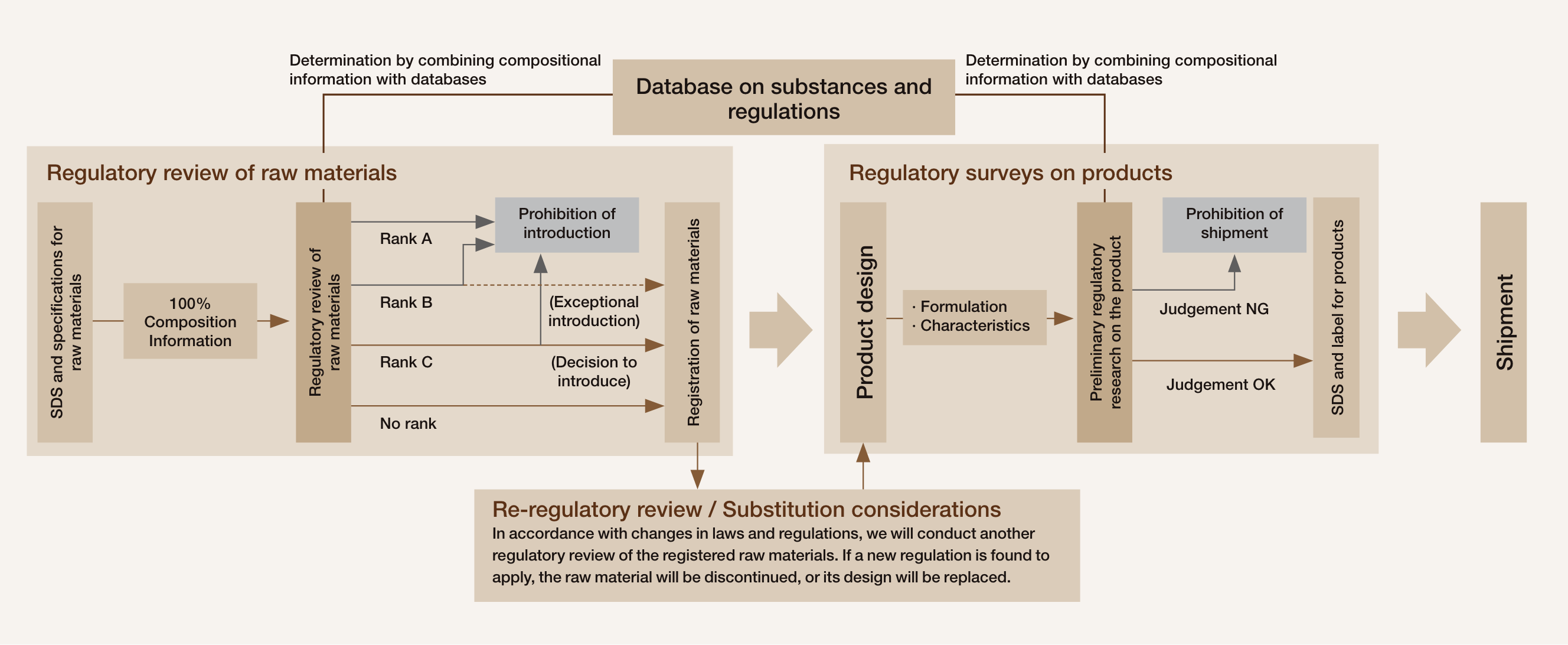Management of chemical substances

Our products comply with the Hazardous Chemical Substance Regulation
Chemical substance management
In 2021, Japan Group launched the “Green 30” chemicals management system to minimize the impact of chemicals on the environment and public health. The system is designed to manage chemicals of concern based on regulations or treaties such as REACH regulations in EU, TSCA in the USA and CSCL in Japan.We classify chemical risks in three categories (Rank A, Rank B, Rank C) according to the laws and regulations in the countries where we operate. Japan Group started using this system in 2021 and the system is being expanded to our partner companies outside Japan.
Alkylphenol ethoxylates (APEs) are mainly used for surfactants and include the subcategory of nonylphenol ethoxylates (NPEO/NPE). Nonylphenols (NP), raw materials for NPE, are regulated by REACH and TSCA. Nippon Paint Group has been steadily phasing out APEs-containing surfactants.
In addition, we have been replacing UV absorbers such as UV-328 and UV-327 that are considered as persistent organic pollutants (POPs) with other substances. In Japan Group, the phase-out of UV-328 has been completed by the end of 2023. Moreover, in Japan we are reducing the use of chlorinated paraffins, including other POPs, medium-chain chlorinated paraffins (MCCP, with carbon chain lengths in the range C14-17 and chlorinated content of 45% by weight or more).
|
Chlorinated paraffins usage (2019=100) |
UV-328 usage (2019=100) |
Chemical substance management flow

* The definitions of categories
Rank A (Prohibited): Prohibition of introduction
Rank B (Restricted for new introduction): Prohibition of new introduction with some exceptions
Rank C (Avoid new introduction): Decide whether or not to introduce based on regulatory trends, environmental impact, and the business environment
No rank: No impact on raw material introduction
Initiative As of July 31, 2024
Japan Group
In 2021, Japan Group launched the chemical substance management system named “Green 30,” in order to minimize the impact on environment and human health. The system is developed to manage chemical substances not only from Japanese chemical regulations, but also chemical substances of global concern from international treaties such as REACH regulations. We classify the chemical risks in three categories according to the laws and regulations in the countries where our business operates: prohibited, restricted for new introduction, and avoided for new introduction. The system started in operation in Japan in 2021, and the practice is being introduced to our partner companies outside Japan.
Alkylphenol ethoxylates (APEO) are surfactants and include a subcategory of nonylphenol ethoxylates (NPEO/NPE). These types of nonylphenols (NPs) are being regulated by the EPA and REACH. Nippon Paint has been steadily phasing out APEO-containing surfactants. In 2021, we eliminated the use of the nonylphenol compounds in our products in Europe.
Dunn-Edwards
In 2019, Dunn-Edwards successfully converted its entire portfolio to low-VOC, water-based products. Dunn-Edwards is firmly committed to the over-arching green principle of eco-efficiency. We define “eco-efficiency” as the ability to satisfy human needs in ways that minimize adverse impacts on energy and material resources, environmental quality and human health and safety. For us, eco-efficiency means: “do more good,” by optimizing the performance of our paint products, and “do less harm,” by reducing or avoiding the use of harmful ingredients. Other green principles flow from the principle of eco-efficiency: resource conservation, energy efficiency, waste minimization, recycling, emissions reduction, health and safety protection, and social responsibility. Consequently, our paint formulations do not include – among other things – asbestos, benzene, cadmium and chromium pigments, chlorinated solvents, dioxin, ethylene glycol, formaldehyde, lead, mercury, methylene chloride, or phthalates.
DuluxGroup
The DuluxGroup Product Stewardship program aims to manage risks and increase the sustainability of our products throughout their lifecycle, from raw material purchase through to disposal of used product and packaging. Each year, our businesses assess opportunities and develop action plans to improve the sustainability performance of products in priority areas, including:
- consumer safety and product misuse
- post-consumer waste
- raw materials impacts, including chemical substance management
- life cycle environmental impact and carbon footprint
- packaging, labeling and safety data communication
- distribution
We also have a dedicated program to reduce any risks associated with chemicals in our products, including those with potential for long-term health or environmental effects (""chemicals of concern""). Our group standard identifies prohibited and high-concern chemicals based on toxicological and/or regulatory classifications, and requires the development of either a group position statement or business-specific risk management plans. These are designed to ensure that any risks are being identified and managed to acceptable levels via improvement actions to eliminate or reduce the risks (e.g., reformulation, packaging, labeling, sourcing, marketing). Key chemicals that we are working to substitute, where technically feasible, are alkylphenol ethoxylates (APEs) and non-aromatic aliphatic fluorinated compounds. UV-327 has now been phased out, and a position statement has been developed to prevent future reintroduction.
